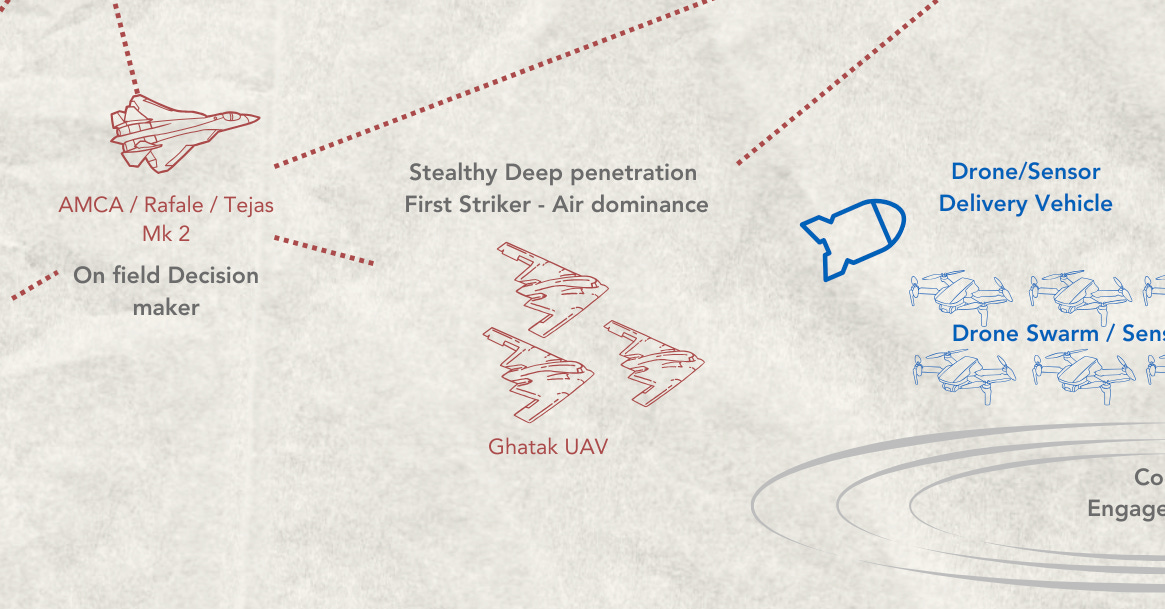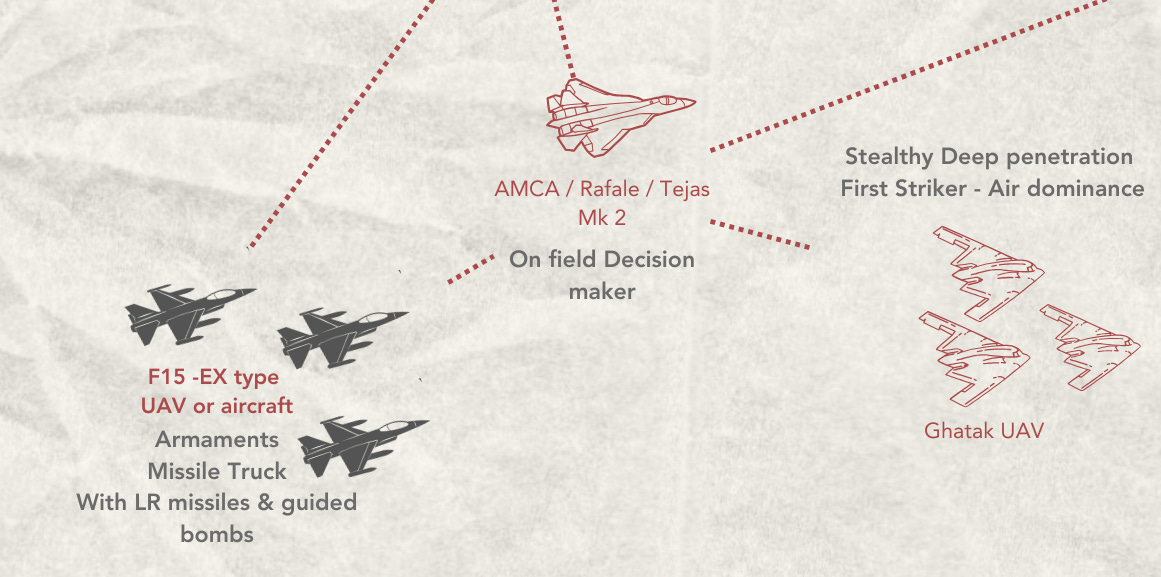IAF-reimagined 2
Exploring how the aircrafts, drones, missiles and Info-sec will shape future air war.
In our previous posts, we have delved into the historical lessons learned in air warfare. We have observed the pivotal role of developing stealth drones, especially for the Indian Air Force.
Now, let us examine some of the emerging concepts being developed in network-centric air warfare of the future that we can deploy within the restrictions imposed on our technical capabilities.
Various roles of Air warfare for the Indian Air Force
The Indian Air Force is expected to perform conflict and non-conflict roles (evacuations of civilians, support during natural calamities etc.) However, we will restrict to the main conflict-related roles:
Guarding the borders
Surveillance of neighbourhoods - Pakistan, China, Nepal, Bhutan, Burma, and Bangladesh borders. India is also required to help protect Nepal and Bhutan.
Active and passive surveillance of the borders involves actual aircraft flying near the borders and radars and navigation monitoring to check aircraft flying into and out of the Indian Air Space.
If hostile or non-responsive aircraft are detected, then the IAF has to put jets in the air to deal with the intruders.
Reconnaissance
This information-gathering role is very crucial. We are focussing on the parts related to the Air Force.
Reconnaissance is of different types.
Long-term reconnaissance uses satellite imagery over weeks or months to check the terrain, changes in terrain (river course changes, landslides, glacier changes, etc.), changes made by opponents, new installations, including bunkers, highways, supply lines, etc.
Short-term reconnaissance - this uses dedicated satellites to check the area at frequent intervals. This is used to check convoy movements, build-up of forces, etc.
Real-time surveillance - is required when you are conducting operations. You use radars, AWACs, drones etc.
Deep Strike
This represents a Balakot-style strike into enemy territory to neutralise the threats to India.
The idea is not to establish long-term air dominance/air superiority but to infiltrate, carry out the mission and exfiltrate quickly without any damage. This may require short-term air dominance.
Air Superiority / Air Dominance
In this role, the IAF is required to establish complete supremacy over the air space, preventing the enemy air force and missile systems from operating.
This capability is required during an all-out war.
Ground Troop support
Here, the IAF will help neutralise the enemy infantry and mechanised infantry, etc.
This requires Air-to-ground attacks.
Ground Troop/Material transportation
This is often an ancillary job of the IAF after the reorganization.
Earlier, all the air-related operations were part of the IAF, and even the military and navy had to rely on the IAF for certain aspects.
Naval Airwing
The Navy has aircraft that need to do all the above operations but in international waters. The challenge is that the Navy operates far from the coast and the distances and range involved are quite large.
The Indian Navy also need to ensure it can create a naval blockade (selective) at the choke points of the Suez Canal, the Strait of Hormuz and the Malacca Strait (including Sunda, Lombok and other points). These operations will involve the use of aircraft.
Winning in the New Engagement Zone
Engagement Zone is the space where you want to conduct your operations. In respect of the present discussion refers to areas inside enemy territory. However, the principles, wherever they may be applicable, can be applied mutatis mutandis.
The first part of any engagement is the information.
As we discussed above, there are three stages in which we need information.
Long-term information usually comes from regular Satellite monitoring.
Short-term information comes from dedicated Satellite surveillance.
But, we also need real-time surveillance before, during and after our operations. We can use radars, AWACs and other equipment for this.
The fundamental principle behind modern-day information is to get your eyes (and senses) into the contested engagement zone at the correct time.
For this, we need Drone or Sensor delivery systems. Once these drones and/or sensor or reconnaissance drones, etc., land in the contested zone, they start transmitting encrypted signals.
These drones can be armed or reconnaissance or mixed.
Alternatively, we can use a cluster of sensors that will gather information quickly (3-6 hours) and light up the zone for observation from Satellite, AWACs or other systems.
These can be delivered inside the zone using a remote missile delivery system or launched from an aircraft or drone.
To ensure we can establish air infiltration,
we can use stealth unmanned drones like Ghatak.
These drones can be coordinated from stealth or semi-stealth aircraft like AMCA/Rafale/Tejas, etc., or remotely piloted.
This is the reason a fully indigenous Ghatak is a game changer. It keeps our pilots out of harm’s way and performs infiltration operations with stealthy precision.
In rare cases, maybe like Balakot, the AMCA/Rafale package can conduct the mission by themselves. The advantage of piloted aircraft is that you have the decision-maker at the scene. Here, exfiltration becomes critical.
Local Decision maker
The pilot in the AMCA/Rafale/Tejas will perform the role of local decision-maker.
S/he needs to be at a stand-off range with respect to enemy air defences but within the range where s/he can strike with his missile package or use the drones to neutralise the threat.
Missile carriers - Missile trucks
Since all the aircraft and drones involved in such a strike are stealthy, their ability to carry missiles and armaments is limited. Thus, you need something to deliver missiles in ready-to-engage conditions in the zone.
An aircraft like the F15EX is ideal for this job. It lugs in 22 missiles, which can then be fired, controlled and targeted by the decision-maker.
But ideally, we can have one F15EX with wingman drones in this role where the armament carrying capacity is very high, and coordination can be shared with the decision-maker.
Support Cast
Now, what we have up here is the main package.
There will be additional equipment in the package, including the AWACs, Airel refuellers, etc.
There will be additional ground support equipment, including Air Defences, Anti-aircraft batteries, missile batteries etc. and the related radar and other equipment.
There may also be more than one aircraft instead of just the one we have for decision-making. If so, then there will be one designated decision-maker in that group.
So what do we need?
The above concept is called Network Centric Warfare and it is not new. What is new is that most of the capabilities required to implement this are now available with India.
Unhackable and robust network connection: When information flow between your defence assets is critical, you need to make them impregnable to enemy manipulation. The manipulation can come through two means. First, the enemy may access, read and change your information by entering inside your network. Second, the enemy may use electronic warfare to disrupt the linkages between your assets either by frying the computers in your equipment or creating interference to degrade the communication.
Drone delivery system: We need mechanisms to deliver swarm drones or sensor clusters into the active engagement zone. These are smaller drones armed or surveillance. Some may be expendable and hence need to be cheap.
More innovations in drone tech: India has been undertaking many innovations in this space, but we need a pragmatic and innovative approach. We also need tolerance for failure.
Sensor clusters: A lot of work is required in this area. While the plan works without these clusters of sensors, the data collection will be more difficult.
Missile Trucks: We need a larger drone or aircraft that can carry large numbers of missiles and bombs to be used in the zone.
AI decision-aids: The decision-making happens at two levels - first at strategic levels in the war room and second in the zone. We need training to make decisions with expanded information and we will need some AI-assistance to aid our decision-making.
In Sum
All of these are within India's technological domain. The main gap was a stealth drone equipped with a local engine, and Ghatak filled in that gap. Now, we need to expand on that and build next-gen capability.








